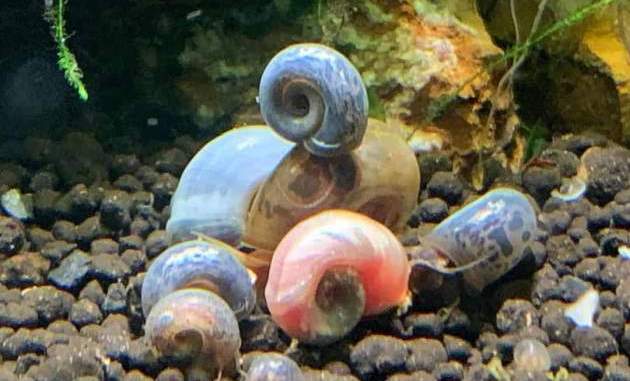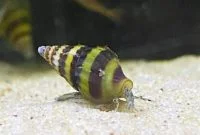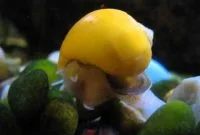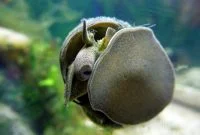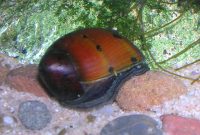Ramshorn snails are an awesome freshwater tiny critter; besides that, they are pretty fun to watch; they also are incredible algae eaters and easy to care for, making them compatible to become an aquatic pets for all levels of aquarium hobbyists.
However, some aquarists consider them unwelcome animals due to their highly prolific behavior. There are possibilities for ramshorn snails to eat aquatic plants; of course, this happens with certain conditions.
Think again before you decide to buy these small tropical aquarium algae eaters. If you believe ramshorn snails are pets or want to raise them for commercial purposes. There are several essential tips that you should know in order to grow them, and It is nicely provided on this page.
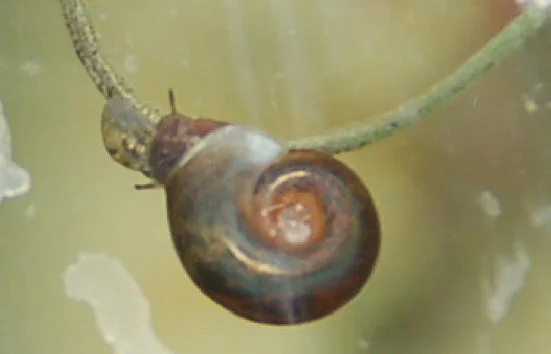
TABLE OF CONTENTS
Ramshorn Snails Overview
Ramshorn snails are freshwater aquatic pulmonate gastropod mollusks under the family of Planorbidae. They are also called ram’s horn snails; in the aquarium industry, this name is used for tropical aquatic snails with planispiral or flat coil-like shells. It resembles a coil of rope or horn of the rams, as their name suggests.
They have abilities to keep a fish tank always clean by consuming anything that has been left by other aquatic inhabitants that were there.
These snails usually move from one corner to another, searching for something that can be fed, such as decomposed plant matter, algae, and debris.
In the trades, ramshorn snails come with wide interesting varieties, so you probably never be bored watching your tank daily. In aquarium stores, they commonly offered about $1 – $3 for each snail. However, purchasing ramshorn snails in a group bundle will be cheaper.
Occasionally, they hitchhike onto aquatic plants you buy from local stores without realizing as young snails or eggs and begin to thrive when they enter your tank.
Origin And Natural Habitat Of Ramshorn Snails
These snails originate from North America. In the wild, they are easily found life in various water bodies such as rivers, lakes, ponds, lakes, and the bottom of swamps. Ramshorn snails often see rise near the water surfaces to breathe the air or graze on algae and vegetation there.
Appearances Of Ramshorn Snails
These mollusk families consist of several species that differ in shells and skin colors. In general, their skin color is red or black. The black ramshorn snails have melanin pigment in their skin, while the red ones do not. So, why do the red ram’s horn snails have a more vibrant color? It’s because their blood, dissimilar to other aquatic snail species, they have hemoglobin blood with red color.
As mentioned above, their shells are described as the horn of rams or spiral rope. Their shells can vary in color; the very common hues of ramshorn snails usually are slightly dull in color, ranging from dark to light brown, and some may be combined with black or dark gray splotches. Nonetheless, if you go to shops or browse on the internet, you might find these snails’ colors more lively. Some species have blue, pink, and spotted shells, making them more attractive when grazing in planted tanks.
Their shells will grow continuously as they get larger. In the juvenile phase, it is so thin and translucent, but as time passes, it can be more robust and darker; the spiral form also becomes bigger as the snail grows.
Unlike most freshwater and marine aquarium snails, they do not have an operculum (a trapdoor at the bottom of the shell). This part functioned as a hard coat that prevented the predators from reaching the mollusk members’ soft bodies.
The existence of trapdoors is ineffective for ramshorn snails due to them being an air-breathing species that need constant respiring to survive. While the trapdoor generally aims to block the air out during the dryness period, it won’t be easy for them to take the oxygen in the air if these snails have an operculum.
How big do ramshorn snails get?
These snails are smaller rather than other famous tropical planted tank snails such as nerite zebra or Malaysian snail, the full-grown ramshorn is usually between 1-2 inches (2-5 cm) in diameter. Commonly, most aquarium shops offered them not bigger than an inch. However, if you give them the best quality of care, their size would be more than one inch.
How long do ramshorn snails live?
Normally, the average lifespan expectancy of ramshorn snails is about one year, both in captivity or natural habitat. However, under the optimal condition, with adequately fed, they can live up to 3 years or even slightly longer.
Unfortunately, sometimes these snails can be death shortly when introduced into a new tank. There are several reasons that caused them to die not too long in the new aquarium environments. Due to moving into the new fish tank, the stress factor is probably a dominant responsible for causing their premature death.
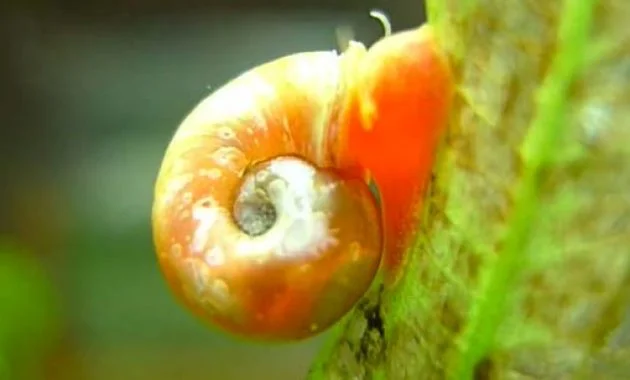
Buy The High Quality Of Ramshorn Snails Only Amazon
Ramshorn Snails’ Behaviour And Temperaments
As much as other freshwater aquarium algae-eater snails species, they are very calm and peaceful. They are not territorial and aggressive toward other congeners or different species. Actually, they are quite active, slowly roaming through the tank day and night, looking for algae. You may see them climb the wall of glass or hang under the leaf plants.
You might notice ramshorn snails eat together in a particular spot. So, when an individual finds a food resource, it is just a matter of time before the others come out from their shelter to share a snack.
They can not run away quickly from predators in the wild or even in aquarium ecosystems, but these snails have a simple and unique way to outwit them. Ramshorn snails can do an uncommon swim method on the surfaces of water, where their shells are upside down. In order to keep the body still balanced there, they allow the water to enter their shells.
When they are in balance condition, they can take advantage of surface tension or even bacterial slimes to swim at the water’s surface.
Well, if their movement is disrupted abruptly and feels dangerous during swimming on the surfaces, ramshorn snails will release the air in their shells immediately and start falling down to the base. That is a little trick for them to escape from the predators.
Are Ramshorn Snails Good or Bad For Aquarium?
These tiny mollusk species are excellent clean-up crew, not only algae but also accept decomposed plant matter and aquarium waste. They are very peaceful and suitable for most aquascaping fish. Of course, ramshorn snails are also very easy to look after and do not need many requirements to keep them stay healthy.
However, some aquarists may dislike these aquatic snails because of their prolific behavior. Under optimal conditions, they can reproduce faster and overpopulate your tank in a few weeks. The ramshorn snail infestation is disturbing for some people because making their tank’s view unsightly.
Are ramshorn snails pests?
In our experience, It depends on the condition and situation. When your tank is performing well, no algae clumps exist. While these snails continue generating their population, they can become a pest that significantly affects ecosystem stability. Nonetheless, if an algae outbreak invades your planted aquarium, they can be a powerful weapon against it. They also will become an additional snack when you keep some puffer fish.
Types Of Common Ramshorn Snails
There are several ramshorn snail varieties that are usually found in the trades, which have different sizes, shapes, colors, and patterns.
Planorbella Duryi
These species are also called Seminole rams-horn, brown ramshorn snails, and brown posthorn snails. They are native to Florida and have become an endemic species there.
Although the wild types are usually brown in captivity, they breed in various colors, making them look more impressive. You can see they come in brighter colors, such as pink, orange, green, red, and blue. Some may have a combination pattern like blue leopard or brown leopard.
In nature, Planorbella duryi lives in fresh water environments such as ponds and streams. They grow around 2.5 cm, and their shell’s texture is relatively smooth. Their shell shape is sinistral and deeply biconcave, the whorls strongly keeled at whorl shoulder with a flat spire in young snails. However, this will be more rounded, and the spires will become concave in adult ones. While the umbilicus is deep, and it seems like a funnel. They also are equipped with thin tentacles.
Planorbarius Corneus
They are relatively larger ramshorn snail species with thick-walled shells. These large planorbids originate from Europe, their distributed areas including Western Europe, Central Europe, Caucasus, Siberia, and the Middle East. The great ram’s horn snail is their common name in the trades.
Planorbarius corneus is commonly found inhabiting a sluggish water movement or still water where pond weeds, vegetation, or algae grow well and contain high amounts of Calcium contents in depths up to 3 meters. They also can be found in water bodies, which often dry out periodically.
Their shells have large sinistral shapes and biconcave, the whorls are rounded, and the spire is concave. A fully grown P. Corneus usually have a shell measuring about 1.4 inch or 35 millimeters.
Their coiled shells are average around 10 – 17 by 22 – 40 mm or 0.39 – 0.67 by 0.87 – 1.57 inch; this typically contains 3 – 4.5 rounded whorls with deep sutures, while the last whorl is more dominant.
The upper side of the shell is slightly depressed, while the downside is extremely depressed (flattened at the lower side, and the spire is recessed at the top side). Their shells do not have a keel. Typically, their shell’s color is light yellowish combined with a reddish, brown, or even greenish periostracum, and the striated is feebly in spirally and radially. The true bodies of great ramshorn snails generally are reddish or brown with thin tentacles.
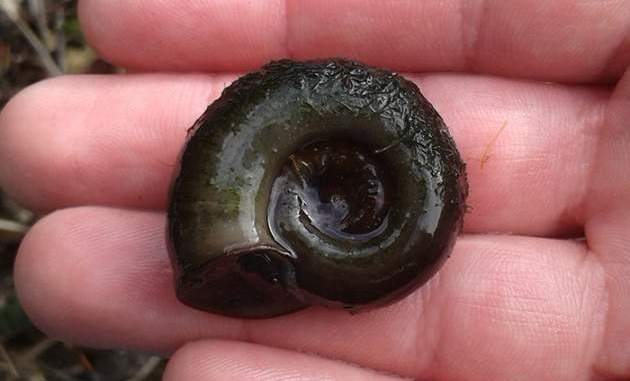
Helisoma Trivolvis
Planorbella trivolis is their synonym name; they are also called marsh rams-horn snails due to their shell shape. These air-breathing snail species are native to Noth America, beginning from northern arctic Canada, Alaska, and Florida. In the wild, marsh ramshorn snails are usually discovered at the bottom of lakes, ponds, rivers, and swamps.
As much like other ramshorn snails species, they have sinistral shell shapes with a flat coil. The color of it usually ranges from dark to light brown, and their true bodies have a similar tint to that. Some of the noticeable body parts include a couple of tentacles, a head, and a foot.
According to a study, the marsh ramshorn snails are known as an intermediate host for the harmful larval parasitic trematodes, that is, Echinostoma trivolvis and Ribeiroia ondatrae. Still and all, they still play a crucial role as algae and decaying materials cleaner crew.

Anisus Vorticulus
Another species of planorbidae family is Ansisus vorticulus or usually called little whirlpool ramshorn snail and lesser ram’s horn snail. These varieties are smaller, with a diameter range of about 4-5 millimeters (sometimes reaching 8 mm but rarely) and a height is about 0.5-0.8 millimeters. They have a brown shell color with a slightly sunken upper side. Each whorl obviously divided by a suture. The terminal whorls relatively have blunt rims in the center of the periphery of the whorl. The aperture is elliptical and commonly slanted.
The lesser ramshorn snails also have red blood and hemoglobin, but it is unnoticeable because of their grey-black body’ skin color.
Whirlpool ram’s horn snails are native to Europe, distributed discontinuously start from England until Western Siberia.
Unluckily, their population in the wild is quite rare due to specific environmental conditions which they need to live. This is caused by eutrophication phenomena, where the water is oversupplied with nutrition but lacks oxygen. Besides, the backwater arms and alluvial water systems are constantly decreasing in nature due to human activities.
They prefer to live in oxbow lakes, ditches, and pools with standing water which contain rich aquatic floras such as pennyworth and duckweed. The Ansisus vorticulus is compatible with water bodies that have clear water, high pH levels, and lower nutrient contents.

Planorbis Carinatus
These pulmonate gastropod mollusks species are also called keeled ram’s horn snails. They are different from their congeners; planorbis carinatus have sharply rimmed outer whorls, called a keel, that might be less obviously set off against the rest of their shell walls.
The position of the keel of planorbis carinatus is in the center of their whorl, while the mouth of the shell is slantwise, and at the upper part is prominent and rounded. Generally, keeled ram’s-horn snails are 2 – 3 millimeters in height with a diameter of about 14 – 17 mm and have about 4,5 – 5,25 whorls.
In the wild habitat, these aquatic snails usually occupy still and sluggish water movement in altitudes of up to 1000 meters MSL with high oxygen levels. They rarely occur in water bodies that periodically dry out. The keeled ramshorn snails primary inhabiting the remains of the glacial water system. For your information, there are dwarf forms of keeled ramshorn snails, which are usually found in the pools in littoral areas of the true water bodies.
The distribution of planorbis carinatus is wider, through all areas in Europe except the south of the Mediterranean peninsulas, beginning from Peloponnesus, Central Italy, to Scandinavian regions like Finland and Sweden.
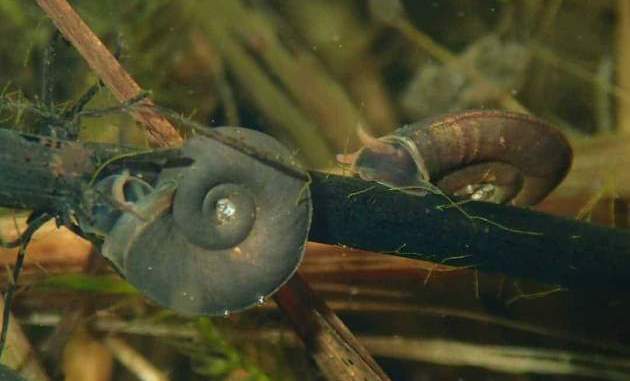
Marisa Cornuarietis
In trades, these freshwater aquarium snails are labeled as “Giant Ramshorn Snails” or “Colombian Ramshorn Snails.” However, they are not real ramshorn snail species at all, although they have a planispiral shell shape. Actually, Marisa cornuarietis belongs to the apple snails family (ampullariidae, sometimes called pilidae).
You can easily be identified and distinguish them from the planorbids family by their two pair of tentacles (real ramshorn only have a single pair of tentacles), they are not hermaphrodites, have a breathing siphon on the left side, and equipped with an operculum (trapdoor).
Their shell color is yellowish and combined with brown lines across the shell; sometimes, they may come only with a solid yellow tint without any stripes. Some also probably consist of two colors: one side is dark, and the other is light.
The adult Colombian ramshorn snails grow up to 2.2 inches (5.5 centimeters) long with a diameter reaching about 1.4 – 2 inches (3.5 – 5 cm) and having 3 – 4 whorls with 3 – 6 spiral brown stripes.

Tank Setup For Ramshorn Snails
Due to their smaller size, there are no minimum tank sizes for them, but we suggested providing 5 gallons or more to make them comfortable. The larger aquarium would raise the possibility of algae growth which they are important for these snails.
They could be adaptable to various substrate types. Well, you can choose whatever you want. Nonetheless, the sandy form and soft gravels are more advised; this is safer for them rather than rough ones.
Remember, they are stagnant and slowly flowing water inhabitants in the wild; you should install a correct water system filtration which does not create faster water movement in the planted tank. You can buy a hang-on, canister, or internal filter machine.
Ramshorn snails do not require a specific light intensity to thrive. Instead, it should be adjusted with live aquatic plants needed if you put some there.
Keeping a few aquarium plants is critical; most aquarium algae prefer to appear on them, especially on old or dying leaves. The ramshorn snails are very love munching on algae and decomposed plant matter. Moreover, they can absorb carbon dioxide and produce oxygen in the water which is very beneficial for most aquarium creatures.
Planting thicker-leaf plants like anubias gracilis is more recommended than the softer ones like java moss or vesicularia; in some cases, they are usually found to bite it when the food sources in the fish tank are in crisis. Adding several floating plants, such as salvinia natans and Azolla cristata, also offers benefits. This can become new places for them to look for food, play, and hide from possible dangerous inhabitants.
Apply a tight tank lid to avoid the ramshorn snails going out of the aquarium. Remember, they are an excellent climber and having abilities to survive outside of the water. Installing a heater is not essential for them.
These little aquarium snails, known as resilient algae eaters, can live in crystal-clear or murky water habitats. However, they do not prefer an environmental condition that can change swiftly. To make them grow healthy, below is a few of the water parameter to stick to:
- pH Levels: 7.0 – 8.0
- Water Temperatures: 70 – 78 degrees Fahrenheit (21 – 26 degree Celsius)
- Water Hardness Level: 5 – 15 dKH
- Water Types: Hard or freshwater
- Water Supplements: Calcium (if the water hardness level is lower)
How To Care For Ramshorn Snails
Water quality is vital in order to keep these snails; this can result in two different outputs. First, it can affect their health level directly. Second is its impact on the development and hardness rates of their shell. So, keeping the water always in optimal condition is key in caring for them.
They are quite sensitive to quick water temperature changes. Your aquascape tanks should be in constant temperature levels, and make sure to put it away from direct sunlight beams. Install an aquarium thermometer to help monitor the warm levels.
Regular water changes are necessary to maintain the water quality, especially if you do not apply a filtration system in your snail’s aquarium. Weekly changes water about 25% into your tank; we recommended using RO water rather than tap ones. It is because tap water commonly contains cooper substances that are harmful to ramshorn snails and even can kill them.
Reverse osmosis water is pretty high at prices, even less if your tank is bigger; of course, you should purchase much. So, we suggested buying a RO water converter for aquaria use. This is simple, it can turn your tap water into RO water, and you can produce it much without spending much money.
Take your test kit, check the water parameter frequently, and if there is an imbalance, stable back it again. Ensure the ammonia and nitrite are always at 0 ppm.
Keep your tank always clean, and suck up the organic and non-organics waste at the bottom of the tank. Scrub off the glass, decorations, and equipment, but you can leave it all not too clean due to stimulate the algae to grow.
Ramshorn Snails Diet And Feeding
Interestingly, they can live in the planted tanks without additional diet resources from the aquarium owners. With sufficient food stocks of algae, decaying small fish, and dead plants, these snails do not need an extra meal.
Although feeding them infrequently happens among the aquarists, still, if the algae populations in the fish tank are lower or the number of ramshorn snails is too big, the hobbyists can supplement them with raw vegetables like carrots, spinach, green lettuces, zucchini, and commercial foods such as flakes or sinking pellets. Remember that overfeeding can promote them to multiply quickly; well, never do this bad practice.
Do ramshorn snails eat green spot algae?
As we know, they love to feed on green algae types, but it’s not correct at all. These mollusks do not like green spot algae due to its texture being tougher for them to eat. Ramshorn snails prefer to graze on soft green hair algae. There are several types of aquarium filamentous green, including rhizoclonium, cladophora, oedogonium, and spirogyra.
Do ramshorn snails eat brown algae?
Yes, they seem to consume soft brown algae that usually stick to stable surfaces, including wall glass, equipment, decorations, and even live aquatic plants.
Do ramshorn snails eat staghorn, black beard, and red spot algae?
These are stubborn and have a hard texture; ramshorn snails seem like tend to avoid them since there are other gentle food varieties that they easily bite. Most algae clean-up crews also often skip them when they arise and leave them to grow until they become a plague.
However, there is a report that ramshorn snails will eat the black beard algae when they are hungry and have nothing else left in their tank.
Do ramshorn snails eat plants?
Actually, they do not eat healthy live freshwater plants if the available food stocks are still enough. In normal conditions, Ramshorn snails only eat the deficiencies, dying, and dead plants. In some cases, they can munch your young plants, most of the moss plants, and even thicker stem plants like anubias species; once again, this happens if there is no food left, and it commonly rarely occurs.
Ramshorn Snails Tankmates
Due to their small size and run slowly, ramshorn snails are vulnerable and become a victim of other aggressive, larger, and predatory fish such as cichlids species, loaches, oscar, pea puffer, amazon puffer, crayfish, tangerine lobster, and others. You should put them with other calm and peaceful aquarium species, such as:
- Mollies
- Guppies
- Platies
- Neocaridina shrimps
- Barbs
- Rasbora
- Tetra species
- Zebra nerite and other algae-eater snails species
- Bamboo and Amano shrimp
- Corydoras
- Sparkling gourami
- Pearl gourami
- Rainbow fish
- Otocinclus
Do bettas eat ramshorn snails?
Remember, betta fish is an aggressive, omnivorous, and territorial species; however, it still depends on the condition and situation. Sometimes they are interested in long antennae on adult ramshorn snails and will nip on it.
Some happily eat their babies and eggs because their size is very fit with betta’s mouth. This can control the snail population in your tropical tanks. Some also will abandon these mollusks without any disturbance.
Do goldfish eat ramshorn snails?
We think putting ramshorn snails with goldfish is a bad idea; remembering this fish is not clever when choosing food. This fish usually try to ingest everything object that comes to his tank, as long as it fits with his mouth; of course, ramshorn is one of them.
The young snails may easily be swallowed by them due to their soft texture and tiny size, but the bigger ones can danger your fish, causing them to choke.
Will assassin snails eat ramshorn snails?
Definitely, yes; in our experience, ramshorn snails are one of their favorite prey due to the absence of a trapdoor and slow movement, which needs less effort to hunt them. Adding one assassin snail is enough to control ramshorn populations in a 5–10 gallon tank size. If the population of this tiny aquascape snail is stable, separate the clea helena to another tank because they will be continuously chased up until no one is left.
Ramshorn Snails Breeding
Can ramshorn snails reproduce asexually? Yes, they are hermaphroditic, which means each specimen has female and male sex organs, so you can put a pair of these snails without finding out their genders first, and they will spawn by themselves.
How often do ramshorn snails lay eggs? Since you provide sufficient food and keep the water conditions as much as they want, they will mate and continuously lay numerous egg clusters. The eggs usually attach to all objects in the aquarium, including wall glass, decorations, equipment, and leaves, or be hidden among the clump of moss/other plants.
What do ramshorn snails’ eggs look like? These snails release the eggs in a globule/cluster, which is clear brownish and translucent, making you can see the fetus inside is white in color. Each cluster generally contains 10 – 12 eggs, and the newborn snails have clearish white color. These egg clutches would hatch in about 2 – 4 weeks, while the new ramshorn snails will reach the reproductive phase about four weeks after they hatch.
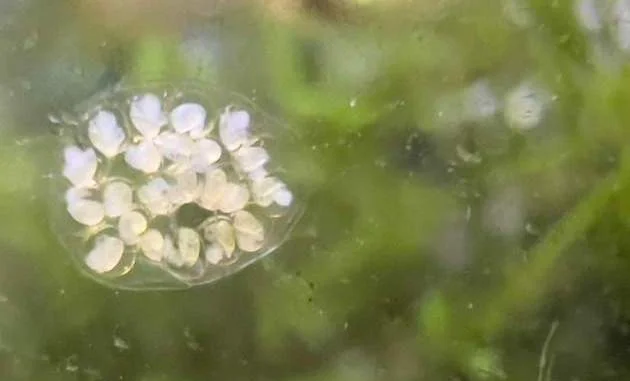
Do not worry about juvenile snails; they can care for themselves and find their food as long as your tank produces algae, debris, and leftover fish food.
Ramshorn Snails Common Problems
These tropical aquatic snails are not prone to a specific disease and can survive from some illnesses that their tankmates carry. Instead, these tiny hardy mollusks are known for bringing very tiny parasitic flukes that are able to be transmissible to fish or even humans. So, quarantining them first for a month is a good prevention way to avoid something worst.
High copper levels in the water are risks for ramshorn snails and other invertebrates; this can be toxic for them and can kill them. Ensure to check if the cure or food types you would add to the tank should be free from copper substances. While the copper sulfate would be effective in getting rid of these snails when they grow uncontrolled.

